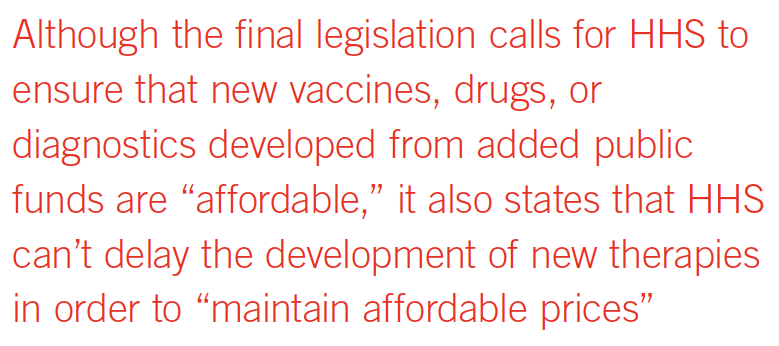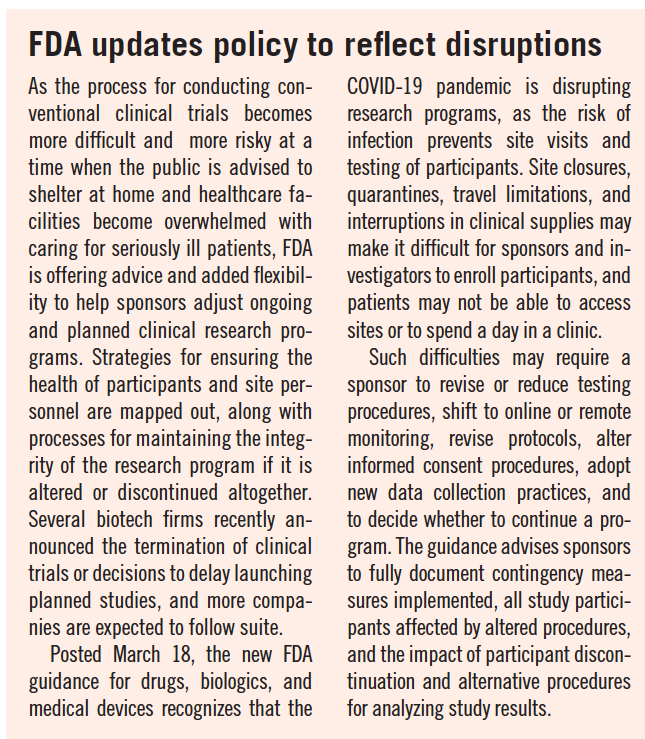Covid-19 Pandemic Thrusts Biopharma R&D to Forefront
Pharmaceutical Executive
Emergency funds for research, public health, and economic disaster raise access issues.
The rush to develop viable therapies and vaccines to combat the spread of the novel coronavirus outbreak continues to focus public attention on the importance of access to vital medicines and diagnostics. FDA and health agencies struggled last month to expand COVID-19 testing after weeks of delay, while Washington policymakers approved measures to fund biomedical research and to support free coronavirus testing plus a
Jill Wechsler

safety net for families and workers hurt by closed schools and job losses. Congress also sought to allay spreading fears of an economic recession with a trillion-dollar emergency coronavirus aid package to send financial assistance to hard-hit companies and cash payments to individuals.
Meanwhile, dozens of biopharmaceutical companies outlined plans for developing effective treatments, as marketers grounded sales forces and halted travel to avoid in-person interactions. The industry also sought to address fears about biopharma organizations potentially making millions from the healthcare crisis and the need to ensure access to critical new treatments.
The pandemic provides the life sciences industry with an historic opportunity to demonstrate how its extensive R&D resources, rapid screening techniques, manufacturing capacity, and willingness to share research findings and clinical trial data can help resolve this global health crisis.
Advancing research
This imperative to halt the COVID-19 outbreak has spurred public and private labs to action. Scientists have identified some 50 existing drugs that may help treat infected individuals, and results from early efficacy trials of repurposed agents were expected to begin rolling out this month.
These projects include clinical studies on antivirals, malaria drugs, vasodilators, corticosteroid agents, immune modulators, and some cell therapies.
A viable vaccine is predicted to take more than a year to emerge, even with accelerated development platforms and advanced production methods. In the middle of last month, the National Institute of Allergy and Infectious Diseases (NIAID) announced the launch of a Phase I trial in record time to evaluate the safety and potential benefits of a much-discussed Moderna vaccine candidate, which has already been studied for SARS and MERS. Pfizer and BioNTech anticipate clinical trials this month for an mRNA vaccine. Johnson & Johnson’s Janssen unit has teamed up with the US Biomedical Advanced Research and Development Authority (BARDA) to evaluate its Ebola vaccine candidate, with hopes of launching clinical studies in November.
Meanwhile, German officials blasted alleged efforts by the Trump administration to shift to the US a vaccine development program by the German biotech firm CureVac, ostensibly to ensure that Americans get first access to any resulting coronavirus vaccine. All sides denied the charges, but the dispute indicates ongoing concerns at home about shortages of vital therapies made overseas.
Continuing cost debate
This reliance on foreign-made medicines has fed fears about drug supply reliability as well as product costs. In the March debate between the two remaining Democratic presidential hopefuls, Sen. Bernie Sanders charged drug companies with looking to profit from the pandemic, as part of his continuing call for a government-run single-payer healthcare system and drug price controls.
Such statements reflect fears that companies developing new treatments for COVID-19 would reap excessive profits, as emerged in the debate in Congress over the initial $8.3 billion emergency coronavirus funding package enacted March 5. Democrats initially sought language to ensure that the government doesn’t overpay

for new pandemic treatments and to allow the feds to take over a company’s intellectual property on a vaccine or therapy deemed too expensive.
Pharma organizations worked with Republicans to eliminate such constraints, claiming a threat to industry R&D investment. Although the final legislation calls for HHS to ensure that new vaccines, drugs, or diagnostics developed from added public funds are “affordable in the commercial market,” it also states that HHS can’t delay the development of new therapies in order to “maintain affordable prices.”
The measure further provides substantial support for new R&D-some $3 billion for developing new vaccines and therapies and $2.2 billion to help expand state and local testing and infection control programs. FDA gains $61 million to support speedy review of new therapies and to deal with shortages due to supply disruptions from China and elsewhere, while NIAID gains $826 million to develop coronavirus vaccines, treatments, and tests. The measure also subsidizes loans to small businesses and supports international efforts to battle the spread of COVID-19 overseas.
HHS also addressed industry liability concerns, which were dropped from that initial bill, by issuing a declaration granting manufacturers protection from liability for medical and security countermeasures against COVID-19. The protection applies to FDA-approved drugs, biologics, and medical devices used to diagnose, prevent, treat, or mitigate a pandemic disease or any serious condition linked to new countermeasures.
Meanwhile, drug costs have remained on the political radar screen. Before the severity of the pandemic fully emerged last month, the Trump administration offered another drug cost-cutting strategy for limiting what Medicare beneficiaries pay for insulin. A voluntary demonstration program for Medicare Part D drug plans
Click to enlarge

would provide insulin products at $35 a month to some 3.3 million diabetic seniors, a big drop from over $400 a month average for such supplies. Sanofi, Eli Lilly, and Novo Nordisk indicated willingness to participate in the demo, while patient advocates complained it doesn’t go far enough: it applies only to more expensive, and not basic, Part D plans and doesn’t actually cut drug prices, but lets the Centers for Medicare & Medicaid Services (CMS) waive certain restrictions so that plan sponsors can negotiate rates with manufacturers and reduce copayments-strategies that critics say merely bolster list prices.
Leaders of the Senate Finance Committee also look to the pandemic to spur Congressional action on its drug pricing legislation, which was recently revised to boost estimated savings to $95 billion over 10 years. The bipartisan bill, which would limit price increases for drugs covered by Medicare and cap out-of-pocket spending by seniors, was approved by the committee months ago, but failed to gain sufficient Republican support. Its backers hope that efforts to ensure access to drugs developed to treat the coronavirus pandemic will increase support for policies promoting affordable drugs for Medicare and other health programs.
Jill Wechsler is Pharmaceutical Executive’s Washington Correspondent. She can be reached at jillwechsler7@gmail.com

Addressing Disparities in Psoriasis Trials: Takeda's Strategies for Inclusivity in Clinical Research
April 14th 2025LaShell Robinson, Head of Global Feasibility and Trial Equity at Takeda, speaks about the company's strategies to engage patients in underrepresented populations in its phase III psoriasis trials.
Beyond the Prescription: Pharma's Role in Digital Health Conversations
April 1st 2025Join us for an insightful conversation with Jennifer Harakal, Head of Regulatory Affairs at Canopy Life Sciences, as we unpack the evolving intersection of social media and healthcare decisions. Discover how pharmaceutical companies can navigate regulatory challenges while meaningfully engaging with consumers in digital spaces. Jennifer shares expert strategies for responsible marketing, working with influencers, and creating educational content that bridges the gap between patients and healthcare providers. A must-listen for pharma marketers looking to build trust and compliance in today's social media landscape.